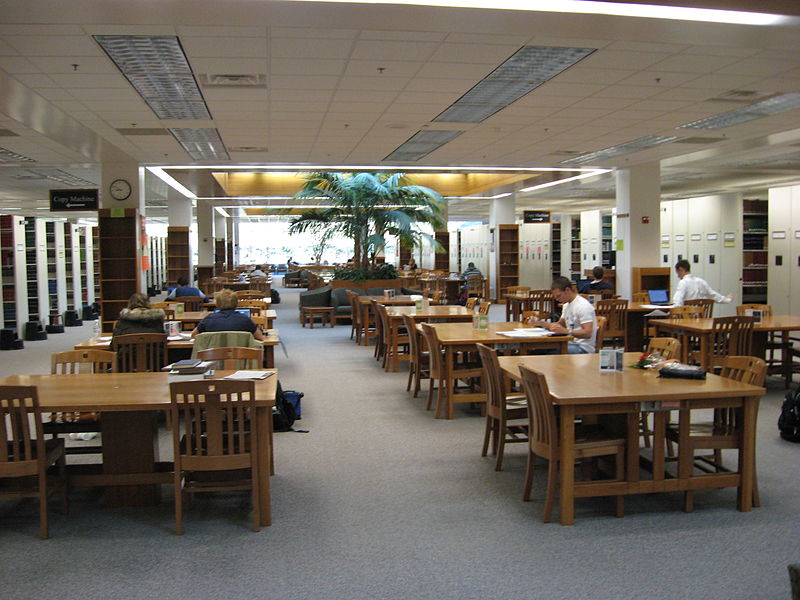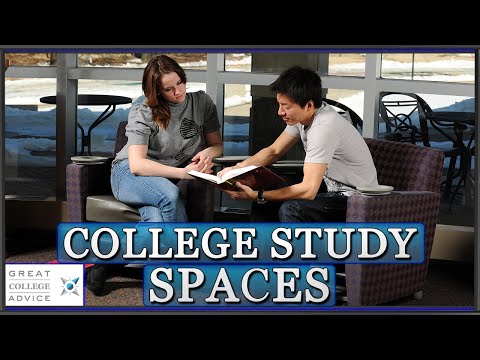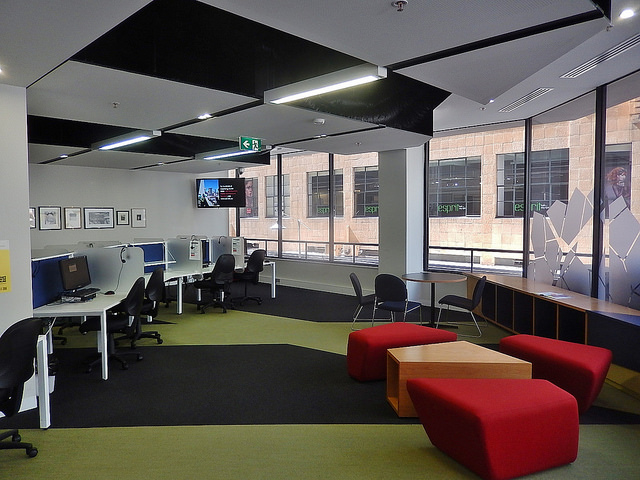4.2: Your Physical Environment
- Page ID
- 85293
I think it’s important to get your surroundings as well as yourself into a positive state . . . –Heidi Klum, fashion model and television host
Learning Objectives
By the end of this section, you will be able to:
- Analyze the impact of your surroundings while you study
- Define distraction and multitasking
- Assess the degree to which personal technology may help or hinder your study efforts
The Impact of Your Surroundings While You Study
If a researcher walked up to you right now and asked you to identify your favorite place to study, what would your immediate response be? Would it be your home—perhaps your sunny kitchen? Maybe your dorm room or bedroom—a relaxed space you can call your own? Maybe it would be a busy café in the heart of town or a remote log cabin, if you have access to one. What are your preferences for your physical surroundings when you study? What are the attributes of your most conducive study environment?
In the following video, Mark Montgomery, an educational consultant and college admissions expert, reminds students that while their image of college may be much about socializing, they will ideally spend a good portion of their time studying. He shows some accommodating physical spaces at Seattle University.
Student Responses
College administrators, like the one in the video you just watched, may have their own ideas about what constitutes good study space. But what do students say? Below are comments from several students about their favorite “go-to” study spots:
It’s not surprising to find that there are some recurring student favorites when it comes to good study environments. The following locations are all-time winners:
- A library
- A bookstore
- A park
- A classroom
- A study partner’s house
- A community center
- A tutoring center
Activity: Factors Influencing Study Spaces
Many factors impinge upon or promote the effectiveness of a study space. In this activity, you identify and reflect on factors that are part of your regular study environment.
Objectives
- Identify factors that impinge upon or promote effective, distraction-free study spaces.
- Examine how the factors are relevant to your personal study spaces.
Directions
- Circle your preferred answer in the table below.
Read more at 11 Ways Your Study Environment Affects Productivity (And How You Can Improve It) from Western Governors University.
| Your Study Environment | ||
|---|---|---|
| YES | NO | |
| Music: Background music is generally “easy” on the ear and can enhance study productivity, as well as drown out other distractions. Depends on your personal tolerance, though. Headphones negatively impact memory and information retention. | ||
| Background noise: Volume of noise and persistence can be major distractions. Try out other environments. | ||
| Smells: Any smell, delightful or otherwise, has the potential to pull your attention away from your work. You may want to change your spot. | ||
| Lighting: Good lighting is essential. Without good lighting, you may strain or squint, get a headache, or tire. Be aware of the lighting conditions. | ||
| Temperature and humidity: If either is too extreme, it can make you uncomfortable and get in the way of effective studying. | ||
| Facebook, email, smart phone: Distractions come in all sizes, shapes, and colors. What draws your attention away from the task at hand? Remove all distractions. | ||
| Comfort—too much or too little: Too much of a good thing can be counterproductive. Best to study at a desk in a good chair, sitting up straight, rather than in bed, lying down. Be aware of how you feel. | ||
| Associations with other activities: Make sure that you associate the environment you’re in with schoolwork, study and concentration. Try new spaces if the associations are not supportive. | ||
| The clock: You may wish to set time goals for your studies. But avoid “being a slave” to the clock. Be clear about what you intend to accomplish and how much time you want to devote. | ||
| Other people: Depending on who the people are, they can help or distract. Study groups can be very helpful, but housemates all around can be distracting. Know your limits and your weaknesses. | ||
| Feng shui: This is the art of placement in your physical environment. Nurture your thoughts, emotions, and senses with good organization of furniture, knickknacks, etc. Avoid feeling cramped. Create a clean, neat workspace. |
Does this exercise give you any ideas for ways in which you might change where you study? How might you alter your physical environment to better support your schoolwork?
Distractions and Multitasking
“Multitasking”—doing several things at the same time—has become a common word for describing what many of us do every day in the modern world. Our busy lifestyles and our ever-present devices suggest that many of us have become multitasking experts.
But is multitasking real? Is it possible to do several things at the same time? Can we actually check Facebook, watch television, read a textbook, and write a paper at roughly the same time . . . productively?
Switch Tasks = Lose Productivity
Evidence suggests that multitasking is not, in fact, possible. Psychology research shows that we can attend to only one cognitive task at a time.[1] What we call multitasking is actually just switching back and forth between tasks quickly. This isn’t necessarily a problem, but we lose time with each switch. The loss may only be one-tenth of a second, but the time adds up. Think about your own experience.
Busy Brains
Researchers have found that multitasking increases production of the stress hormone, cortisol, and the fight-or-flight hormone, adrenaline.[2] These hormone-level increases can cause the brain to literally overheat, which leads to foggy mental processing. So multitasking while studying for a final exam might not be a good idea.
Multitasking also taxes the prefrontal cortex, the part of the brain that integrates information. Your capacity for problem-solving decreases with the number of tasks you try to perform at the same time.
Personal Technology: Helping or Hindering Your Study Efforts
The perceived need to multitask is driven largely by the technology takeover of recent years. Smartphones, email, social networking, Instagram, Twitter . . . all make multitasking seem both necessary and possible. They all require switching in and out of a line of thinking. With these technologies, we face constant information overload and distraction.
Becoming More Productive
How can we become more productive with our time and energy, given our tendency to multitask? Read the tips below:
- Try “batch processing”: Have set times during the day for checking and responding to emails.
- Use concentrated time: Block off time for working on just one task. You may need to turn off your phone.
- Do what’s most important first: Make goals for the day and accomplish them. The sense of achievement can help you resist anxiety-driven multitasking.
What are your thoughts on multitasking? How does it affect your productivity? The following video, from the University of British Columbia, features students talking about multitasking. Does it exist? Is it effective? Listen in, or view the full discussion.
Activity: The Perils of Multitasking
Objectives
- Examine the aspects of multitasking that modern society experiences.
- Take stock of statistics about the perils of multitasking.
Directions
- Review The Perils of Multitasking, an infographic from OnlineCollege.org.
- Take notes on highlights of the infographic.
- Complete the self-check quiz on multitasking and your physical environment, below, by choosing the best answer.
https://assessments.lumenlearning.com/assessments/852
- Your Physical Environment. Authored by: Linda Bruce. Provided by: Lumen Learning. License: CC BY: Attribution
- Image of modern workspace. Authored by: Michael Coghlan. Located at: https://flic.kr/p/kgJrSu. License: CC BY-SA: Attribution-ShareAlike
- Students Talk: Multitasking. Authored by: JWang. Provided by: UBC Learning Commons. Located at: http://learningcommons.ubc.ca/students-talk-multitasking/. License: CC BY-SA: Attribution-ShareAlike
- UBC Students Talk: Multitasking - Does It Work?. Authored by: UBC LEAP. Located at: https://youtu.be/QStKeI9Bluc. License: CC BY: Attribution
- Educational Consultant Explains Importance of College Study Spaces. Authored by: GreatCollegeAdvice. Located at: https://youtu.be/hJzAxhnrMGg. License: All Rights Reserved. License Terms: Standard YouTube License
- Image of library. Authored by: Eustress. Located at: https://commons.wikimedia.org/wiki/File:HBLL_periodicals.JPG. License: Public Domain: No Known Copyright





